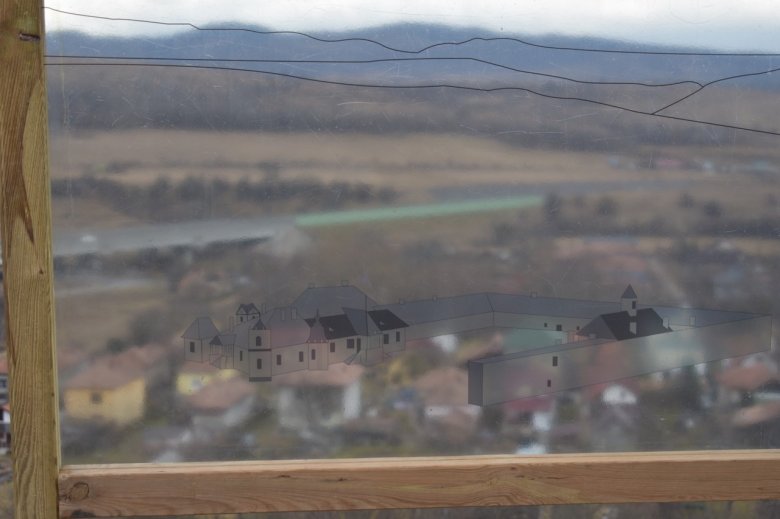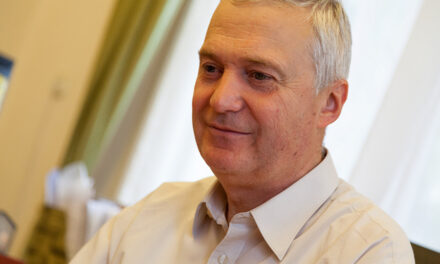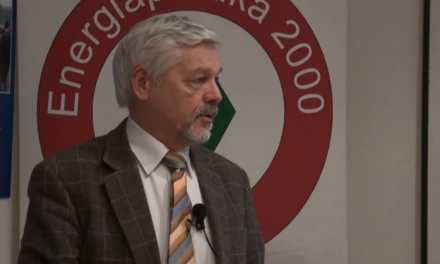The realization of the goal forged a community.
The Jósika Castle in Magyarfenes, demolished at the end of the 1930s, can be seen again - the local Csicsal Association announced on its social page in recent days. Well, it is not visible as the building complex once dominated the village, and not from anywhere. Based on a contemporary photo, the organization had the silhouette of the castle made and applied to a glass sheet, which it placed on the Csicsal hill rising above the village, near the place where the photo was taken. If you look at the village through the frame, you can see the outline of the castle that no longer exists.
It is impossible not to notice the Csicsal hill in Magyarfenes. If you drive towards Tordaszentlászló on the county road that crosses the settlement, you will see the cone-shaped hill directly opposite in the center of the village, which rises about eighty meters above the settlement. Its height does not seem much, but if we consider that the 25-story West City Tower, built at the Szaszfenes exit of Cluj-Napoca, is only close to one hundred meters, it is enough to provide a magnificent view in all directions of the wind rose.
According to local custom, on New Year's Eve, on the steep slopes of the hill facing the village, the numbers of the passing year and the new year are laid out from loops twisted from rags, which are then lit at midnight.
The numbers of the years are drawn on the hillside from fire on New Year's Eve, and from soot until the spring rush. Due to global warming, snow only covers the hill for a few days in the winter.
Three decorative buildings with arches and tympanums once stood on the hill. The gloriette was certainly built by the Jósika barons, whose castle stood at the foot of the Csicsal, in the triangle bounded by the Fenes stream and the Rákos stream. According to his last will, Aladár Jósika was also buried on the hilltop in 1914, who ended his life with his own hands. The baron's ashes were later exhumed and laid to rest in the Házsongárd cemetery in Cluj.
Although neither the castle nor the gloriette is standing anymore, the place of the grave has also been overgrown with bushes, the hill is still considered a symbolic place of Magyarfenes.
The painter Péter Balázs (1919-2003), who was born in the village, also immortalized its view in his many pictures. It is not surprising that the labels of cheeses and dairy products produced in Magyarfenes include the Csicsal hill and the words "Kalotaszeg delicacy".
The joy of volunteering
We will arrange a meeting with Béla László K., the vice president of the Csicsal Association, on the hill. The young man, who works in Norway, but manages the organizational part of the construction work mostly from his native land, arrives at Csicsal with a board on his shoulder, to the frame fixing the outlines of the castle. He explains: after setting up the frame, it turned out that the angle from which we look towards the village is extremely important. Therefore, he also brought a board, on which he cut a gap, to help him see the castle.
You have to look down on the village through the gap and the frame, so that you can see the outline of the castle in the right place and in the right size.
László K. Béla enthusiastically tells about the community spirit that was manifested in the Csicsal case in Magyarfenes. He notes: the fact that it was possible to buy the top of Csicsal and a lane leading to it from the side of the hill is a source of confidence. With voluntary work, a serpentine road was created on the lane, which makes the ascent easier, and now the silhouette of the castle was completed with voluntary work.
Pál Csatlós, the owner of the advertising graphic workshop Promoteus in Cluj, saved the outlines of the Jósika estate from a contemporary photograph on a transparent film. In some places, he had to draw afterwards, because the outlines were covered by trees in the recording. He notes that the transparent film glued to the glass may not be durable, so they are looking for the possibility to engrave the outlines in the glass using NCN technology.
Community space with community funding
In September 2023, it was announced in the Let it be ours again Facebook group called Csicsal tető that the purchase price of the 1.71 hectare area, the negotiated 34,200 euros, had been collected. When asked why it had to be purchased, he says: they felt that the symbolic place should remain community property. This is because in a settlement with a population of one thousand, which belongs to the catchment area of Cluj-Napoca, and is inhabited by Hungarians in the overwhelming majority
more and more plots are changing hands. We had to act before it was too late.
He adds that even before, everyone felt that the area belonged to the community, because the owners never addressed the visitors.
He says about his personal motivations: he grew up in a house just a few hundred meters from the foot of the Csicsal, as a child he was constantly running around the Csicsal, and it also seemed like a fairy tale to him when he found out that there was once a castle in the village. As a teenager, he already went to the Csicsal site with his children to mow, and as a family man. The vice president of the association recalls that it was decided to purchase the hilltop in 2020. However, the deal did not go smoothly. They agreed with the sellers on a purchase price of one euro per square meter, but when they were invited to sign the contract at the local cultural center, in the presence of the notary, they were faced with the fact that the sellers had changed their mind and doubled the price.
"We met with Tibor G. Kun, the president of the Csicsal Association, and made the decision in a matter of seconds: We will also collect the doubled price"
recalls Béla K. László.
Fundraising took three years. During this time, the members of the Magyarfenes theater group operating within the framework of the Csicsal Association went through the village several times and knocked on every house for donations or with forms for the 3.5 percent tax offer. They usually took every opportunity to raise funds. The income from the performances of the actors and the price of the food sold at the carnival ball also served to purchase the area.
The realization of the goal forged a community
The community activist says that when they decided to buy the high-rise, they had no idea how to raise the money. What they had to do and how they had to do it was constantly evolving.
"Whoever had an idea, we listened to it, implemented it as much as possible, or helped to implement it"
he recalled. The main communication channel was the village's Facebook group. There, they gave accurate information from time to time about how much money had been collected and how much was still missing.
Complete transparency and selfless, devoted, voluntary work were an important component of the trust that developed in them, without which it would not have been possible. László K. Béla believes that the purchase of Csicsal has become a means of community building in the village. He noted that many people had moved to the settlement in the last decade. This case also involved them in the community, they started to feel like Hungarians and started to be proud of their settlement.
Purpose of the space
László K. Béla says that in Norway, he has seen that in some places, in bus stops, parks, old telephone booths, but also on the beach, open-air libraries are created, from which anyone can borrow books. This is how the idea came to place a waterproof bookcase on the Csicsal and put books and chess in it. A bench was also built for the visitors so that those who read in the beautiful surroundings would have a place to sit. The collection of books expanded over time. Books brought by visitors also appeared in the cupboard.
When asked if there are any readers, László K. Béla mentions: it happened several times that when he climbed to the top of the hill, he saw a person reading on the bench, but there was also a case where he was sent a photo of a chess party played with chess kept in the library cabinet. There is also a slide on the hill and a stretched belt on which you can practice balancing. The fixing of the slide had just broken when we were there.
The community activist looks disapprovingly at the years emerging from my age. He states: he does not pay for environmental pollution. In the longer term, he thinks it is most acceptable to lay out the numbers from dried hay cut in the area and light the numbers on New Year's Eve. However, he says that the years also increased for Magyarfenes. The truck driver's brother-in-law, for example, sees them and determines that he is passing the village on the highway.
In its latest appeal, the association initiated the planting of Jósika trees on the Csicsal.
Not many people know that a type of organ was named after the Jósika barons. They found a description on the internet that at the end of the 19th century, with a lot of work, the Jósika tree, whose Latin name is syringa josikaea, was recognized as an independent species. The tree can be found on almost every street in Magyarfenes, so the locals were asked to give a stem or two to those who have young shoots to plant in Csicsal.
The reconstruction of the gloriette was also formulated as a long-term goal. However, the solution was to build it with light in accordance with the possibilities of the 21st century and display the former building in a hologram.
Until then, however, there was another goal. In January 2024, they knocked on every house in Magyarfenes and thanked them for the support for the purchase of Csicsal with a gift calendar. At the same time, they filled out the tax offer forms with which the money is now being collected for the funeral planned for the church cemetery of the village.
A castle in memory
We learn from Tibor G. Kun, the president of the Csicsal Association, that his father, György Kun Gazda, visited the castle when he was a child. Uncle Gyuri is waiting for the journalist's visit so that he can share his memories. He is the oldest person in Magyarfenes, who just turned 94 today, February 16.
I must have been 6-7 years old when I visited the castle, I even walked around in the attic. Back then, village children were very rambunctious. The castle had already been sold, the baron no longer lived here. The building was sold in 1936, and it took two years to demolish it, as it was a very large castle surrounded by the castle wall. There was a two-story gate-like entrance. It may once have served military purposes. And there were the farm buildings"
he recalls. As he recalls, at the beginning of the 20th century, the estate was owned by two Jósika brothers: Aladár and Gábor. Aladár was called a foolish baron in the village. He committed suicide in 1914.
"He wasn't a fool, he was just called that, he also stopped talking to the peasants"
Uncle Gyuri recalled. Gábor's son István was the last owner of the castle. In the village, he was only referred to as Baron Pisti.
György Kun Gazda knows the reason: the Jósika family sold their castle because the Romanian land reform took most of their wealth into state ownership, and there was no longer anything to maintain the manor. At first, the agricultural lands of the village were sold, they were bought by the locals, and then the castle was acquired as well. He remembers that
there was also a purchase offer of 2.5 million lei for the castle from Romanian lawyers, but the baron sold it to the villagers for 1.5 million lei.
He insisted that the estate should be owned by the local people, even at a loss. The inhabitants of the village, under the leadership of István Kun, joined forces to buy the castle, in order to then demolish the buildings and use or sell the building material. Uncle Gyuri also knows that the tower cap of one of the castle's four towers was bought by a local carpenter.
The tower cap still decorates the Magyarfenes family house he built. The tower cap of the main gate was placed on the tower of the neighboring Járarákos Greek Catholic (currently Orthodox) church.
Featured image: You have to look down on the village through the gap and the frame, so that you can see the outlines of the castle that once stood in the right place and in the right size • Photo: Gazda Árpád












